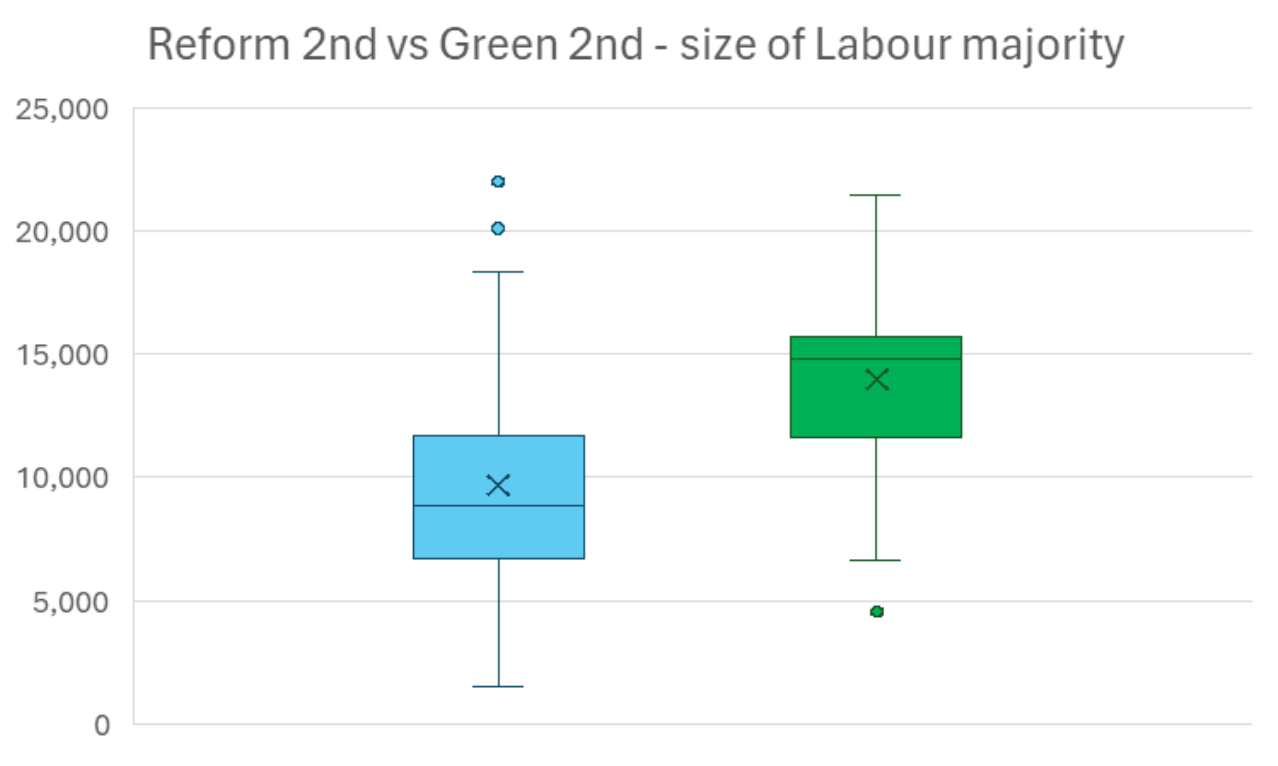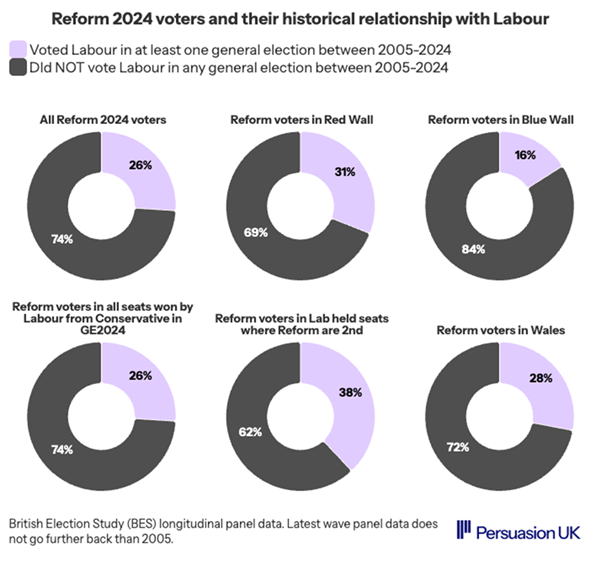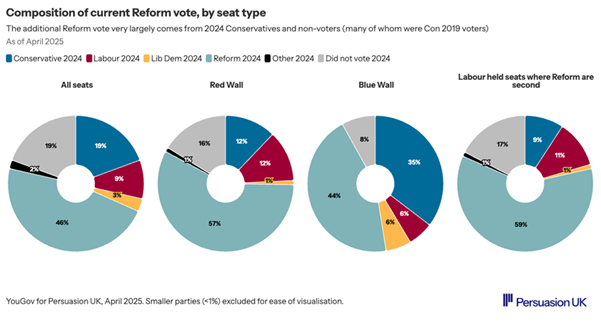
Following the local elections, some are claiming that progressive parties, particularly the Greens and the Liberal Democrats, are more of a threat to Labour than Reform is.
I have to say that as an MP in County Durham, where Labour went from 56 of 126 seats in the old council to just four of 98 in the new council following boundary changes, and where Reform now has 65 of those 98 seats, my initial reaction to such a claim is for my jaw to drop that anyone could propose such a daft analysis.
Taking the specifics of my own constituency, North Durham, the Labour vote fell from 9685 to 6694 between the 2021 and 2025 county council elections (total turnout was about the same), Reform went from zero to 10,828 votes, the Tories fell from 6,585 to 1,911, and various brands of local, originally anti-Labour, independents fell from 7,255 to 5,011. The Lib Dem vote hardly changed, up marginally from 2,687 to 3,048, and the Greens fell marginally from 1,191 to 1,094.
Unless there was quite extraordinary differential turnout of potential Labour voters between these two elections, the story seems to be one of Reform cannibalising a very large slice of the previous Tory and Independent vote, but also making substantial direct gains from Labour. The Lib Dems and Greens were really not a factor here or in other seats with similar demography.
READ MORE: ‘Prospect of PM Farage keeps me awake at night,’ says leading union chief
This was reflected in our canvassing as well – we repeatedly met people who were long-term Labour promises from previous elections now switching directly to Reform, and other MP in similar seats with Red Wall characteristics have described a similar pattern. I set out why voters told us they were unhappy in this article.
The two local Labour councillors we still have in my constituency represent two more socially and economically mixed wards, one of which we even gained from the Tories. The more working class and economically deprived a ward was, the sharper the swing to Reform. The wards we lost had in many cases been Labour bastions for over 100 years, since Labour first won Durham County Council in 1919, and had been held by healthy margins even when we initially lost control of the council to an anti-Labour coalition in 2021.
Although as its local MP, I obviously consider North Durham to be the centre of the political universe, I accept my anecdotal experience won’t convince everyone, so this article now needs to shift and look at the national picture to bust the myths that make up this “progressive illusion” about the relative threats.
Myth 1: Reform gain = Tory pain
Ahead of the local elections, Tom Baldwin claimed in The Times that “…the Conservatives… are also continuing to supply Reform with the vast bulk of its increased support.”
While this was true in my seat, it didn’t stop the primary victim of the shift in votes being my Labour councillors! We can’t actually control Kemi Badenoch’s iteration of the Tories being rather rubbish and losing so many votes to Reform, but we can try to stem the extra ones that we are losing direct from Labour to Reform – just hoovering up Tory and Independent votes might have given Reform maybe two councillors in my constituency, because there wasn’t a huge 2021 anti-Labour vote to begin with, not the 12 they ended up with.
Analysis by Steve Akehurst of Persuasion UK (no relation despite our shared surname, and someone with slightly different politics to me!), detailed below, shows that whilst nationally that’s the pattern, generally in the Red Wall and in seats where Reform came second, Labour is losing the same or more votes to Reform than the Conservatives are.
Myth 2: Progressive parties will be Labour’s primary opponent at the next general election
Some argue that Labour needs to be more focused on the Greens and Liberals at the next general election. This is a blatant misreading of electoral reality.
The Conservatives came second to Labour in 219 seats and Reform came second to us in 89 seats. By contrast, the Green Party came second to Labour in only 39 seats and the Liberal Democrats in just six of our seats.
It’s clear that progressive parties will not be Labour’s main electoral opponents at the next election. They will be a specific opponent in certain places, but we can’t build a national strategy around a small subsection of rather idiosyncratic seats.
We tried a strategy based on hoovering up progressive votes in 2015 (Ed Miliband’s 35 percent strategy) and under Jeremy Corbyn in 2017 – in both cases it super-inflated our majorities in big cities and university towns whilst failing to help us get anywhere near the 326 seats we needed to win.
READ MORE: More voters say Labour doing bad job delivering missions
Myth 3: Labour should be more worried about losing votes to progressive parties than Reform
Tom Baldwin recently claimed in The Times that “Weekly surveys for YouGov consistently show Labour losing a chunk of its 2024 support to Reform, but a lot more of it is going to the Liberal Democrats and Greens.”
In national opinion polling, this is true.
However, this analysis misses a fundamental point about how parliamentary elections work. What matters under First Past the Post is in which constituencies votes are being won or lost. As we saw in Myth 1 above, Labour is now clearly losing votes to Reform in its former heartlands and in the battleground Red Wall seats which went Tory in 2019 then swung back to us in 2024. The votes lost to the Greens and Lib Dems are a) more likely to be in seats that are safe enough that we can afford some loss of votes and b) easier to make a tactical voting appeal to in seats where neither of those progressive parties is the main challenger (i.e. in well over 75% of Labour-held seats).
There just aren’t that many constituencies with the kind of demography that would ever enable the Greens or Lib Dems to be the main threat to Labour. They do exist, particularly in university towns, but in nothing like the numbers of seats where a potential for a Reform or Tory win exists. The Lib Dem campaigning infrastructure and councillor base that existed in Labour-facing urban seats before 2010 no longer exists, and their strategy is not to target such areas as they feel it conflicts with the new political priority for them of appealing to wealthy but socially liberal ex-Tory areas.
In the 2024 general election, we correctly focused particular organisational and political effort on “hero voters” who had been Tory in 2019 but were considering Labour in 2024 and lived in Lab vs Con marginal seats because such voters had double value in such contests – if they switched directly to Labour it reduced the Tory lead in their seat by a net two votes, whereas a voter Labour gained from a third or lower placed party or from previously not voting, whilst welcome, only reduced the gap between the Tories and Labour by a net one.
In the next general election, in seats where Reform was already our main challenger in 2024 or has supplanted the Tories as such since the General Election, the new “hero voters” who we will need a particular organisational or political focus on will be those worth a net two to the gap between Labour and Reform because they could potentially vote for either of those two options. The usual caveat that extra votes in the Labour column who might otherwise have voted Green, Lib Dem, or not at all, are hugely welcome is still there, but these will only have half the value of people persuaded to switch back from Reform or not to switch to them at all.
READ MORE: Three Labour MPs to change vote and oppose assisted dying bill
Myth 4: The seats to worry about are being challenged by the Greens or Lib Dems

We’ve already seen that there are relatively few Green-Labour or Lib Dem-Labour contests. But what about the idea that these seats are more marginal and as a result more of a threat to Labour?
Again, this is not the case. As shown in the chart below, Labour’s majorities are much smaller in seats where Reform came second than in seats where the Greens or Liberals came second.
This is because the Greens are challenging Labour’s metropolitan, inner city vote, where the Labour vote is in many cases still a lot higher.
Myth 5: Reform voters have never been Labour, so we might as well write them off
What about the idea that Reform voters have not voted Labour for a very long time, if ever? And, as a result, can be seen as voters for whom the Labour horse has already bolted?
Analysis again by my non-related namesake Steve Akehurst of Persuasion UK again dispels this.
In the seats that matter, for example the Red Wall and seats where Reform came second to Labour in 2024, we can see that many Reform voters have recently voted Labour.

‘We have seen this story before – and I’m determined to try and stop it’
Having looked at the myths, I would conclude by asking what the primary purpose of the Labour Party is. It was set up to provide a voice in Parliament for the kind of predominantly working-class, industrial then but sadly post-industrial now, communities, like North Durham, whose economic interests were not being represented by the middle-class orientated Liberal Party, after the failure of attempts initially by the unions, particularly the miners’ union, to make their case from within Liberalism rather than create a separate party.
The Greens and Lib Dems aren’t a threat in these traditional working-class Labour heartlands because they have very little to offer them.
If, which isn’t the case, we could build a path to 326 MPs and a Labour Government that ran through the kind of more middle-class areas where our challengers were the Greens or Lib Dems, but at the expense of ignoring or being less responsive to the political and economic concerns of the very communities and people our party was set up to represent and fight for, what’s the point? What’s social democracy and the Labour Party for if it’s not to represent the political and economic concerns of working people and the communities that have been most ravaged by free market economics?
READ MORE: Usdaw’s new first female leader on wealth taxes, workplace AI and holding Labour’s feet to the fire
Are some comrades so squeamish or snobby about engaging with angry working-class voters who are being attracted by Farage and Reform because of despair that their economic woes and the long-term economic decline of their communities isn’t being addressed fast enough, that we would just allow the places that were the cradle of our movement to be snatched by the far right?
I fear that the lopsided geography and demography of Labour’s membership, which is heavily concentrated among graduates living in big cities or university towns, means that many members care more about the opinions of the relatively small number of voters, distributed in places that aren’t that crucial electorally, who look and sound like the people they work and socialise with, and conveniently whose political priorities and prejudices happen to coincide with their own.
They therefore invent convoluted mythologies about why those voters are far more important than the people from the communities that literally created the Labour Party such as those I represent as an MP, further fuelling their resentment against a dismissive political and media bubble.
We’ve seen this story before, it led to the Brexit referendum result and it led to Boris Johnson winning the Red Wall in 2019, and I’m determined to try to stop it being repeated and leading to Nigel Farage becoming Prime Minister in 2029.
Subscribe here to our daily newsletter roundup of all things Labour – and follow us on Bluesky, WhatsApp, Threads, X or Facebook.
- SHARE: If you have anything to share that we should be looking into or publishing about this story – or any other topic involving Labour– contact us (strictly anonymously if you wish) at [email protected].
- SUBSCRIBE: Sign up to LabourList’s morning email here for the best briefing on everything Labour, every weekday morning.
- DONATE: If you value our work, please chip in a few pounds a week and become one of our supporters, helping sustain and expand our coverage.
- PARTNER: If you or your organisation might be interested in partnering with us on sponsored events or projects, email [email protected].
- ADVERTISE: If your organisation would like to advertise or run sponsored pieces on LabourList‘s daily newsletter or website, contact our exclusive ad partners Total Politics at [email protected].





More from LabourList
‘No racist is going to make me feel I don’t belong’: Shabana Mahmood on resilience, faith and public service
Delivering in Government: your weekly round up of good news Labour stories
‘Labour should call time on the unfair system that is hurting pubs’